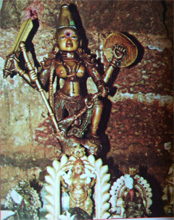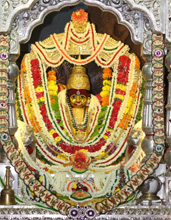The 16thcentury Goa saw the reign of Portuguese and faced their terror intending to spread of Christianity. Goans witnessed the forceful acts of conversion, temple demolitions, breaking of idols of temple deities looting temple wealth and setting on fire the temple buildings. It is during this period our pious ancestors put themselves to risk of life. Leaving behind their homes, property, wealth, agricultural land and even their family and the near and dear ones escaped into the moonless nights across the border with the family deities and their symbols. They crossed through the dense forest, valleys, rivers and hills to set up again the more precious than life image of the family deity in a new temple to protect and nurture the Hindu religion for benefit of future generations.


Therefore laying claim to be their descendants we take pride in being kulavis of the family deities. It is this thought that confers us the responsibility to continue with the worship and rituals of the deity with devotion till time. Among many such family deities is Devi Shree Santeri of Shankavali or shankhval, todays Sancoale of Salcete taluka. Shifted to vaddo of Gothan in the village of Veling of Ponda Taluka and is now known as Shree Shantadurga Shankhavaleshwari. Ponda was under the rule of Adil Shah of Bijapur at these times flourishing beyond the borders of Portuguese rule.
The temple of Shree Shantadurga Shankhawaleshwari is located in a quiet and serene place, an experience beyond description. Areca groves touching the sky, gurgling sweet water streams and brooks, stretch soothing vistas of green carpeted hillsides, dense bushes and scenes of natural beauty embrace you with pleasant smell of forest flowers.
A flight of steps from the tar road leads to the Mahadwar of the Temple complex. Between the Mahadwar and the main temple of Shree Shantadurga Shankhawaleshwari is the deepasthambha and Tulshi Vrindavan in the middle courtyard. The temple faces purva disha with sodiyo that’s the viewers area followed by mahachowk . Recently being renovated the mahachowk shows contemporary touch in the construction of the pillars, beams and the balcony that runs all three sides except the garbhagriha.
Through the dwar of the garbhagriha you get the glimpse of panchadhatu idol of Shree Shantadurga Shankhawaleshwari installed on a pedestal . The religious minded devotees are transfixed and dumbstuck by the sheer spectacle and beauty of the goddess. The devotees get rid of their doubts and fears and experience peace of mind and bow to the supreme power.
In the mantap near the idol are three similar idols of Shree Laxmi Narasinha, Shree Vijayadurga and Lord Ganapati. The mantap is crafted in silver and engraved with fine handiwork. At the floor level just touching the main pedestal is a small panchadhatu idol of goddess which s used for Prasad kowl ceremonies. Behind the main deity is a roinn (Anthill) not visible to those standing at the main door of the garbhagriha. The flooring of garbhagriha, mahachowk, porch, aisle and pradakshina is done with marble and exquisite tiles.
The right of the temple is Agrashala, initial portion for the residence of the priests and archaks. The asthakoni mahachowk and the elevated three spires and two domes structure of the temple give it a beautiful and holy appearance. The temple is lined from behind by eight small temples and garbhagrihas, six of which are installed lingas signifying purvapurushas. The other two include deity of the Grampurusha and Shree Dandapani or Kshetradhipati.
There also appears a tree of ancient origin considerd to be of the devachara where every year gifts are given in form of food like ront to seek blessings. This is where sankhliyo is venerated by the devotees.

